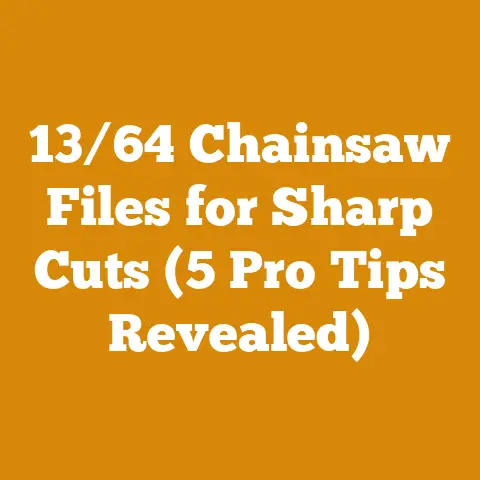Crankshaft Install Guide (No Specialty Tools Needed for Chainsaws)
Ever stared at a disassembled chainsaw, feeling more like you’re holding a Rubik’s Cube than a powerful tool? The crankshaft, that vital heart of your saw, can be intimidating. But what if I told you that, with a little patience and know-how, you could install it yourself, without needing a specialized tool arsenal? Think of the money you’ll save – money you could use for that new splitting maul you’ve been eyeing, or maybe just a well-deserved celebratory beverage after a job well done. This guide is about empowering you to tackle this repair, save money, and gain a deeper understanding of your chainsaw. Let’s dive in!
Crankshaft Install Guide (No Specialty Tools Needed for Chainsaws)
Replacing a chainsaw crankshaft might seem like brain surgery, but I’m here to show you it’s more like a well-organized carpentry project. This guide focuses on techniques that minimize the need for specialized tools, making it accessible to the average DIY enthusiast. I’ll walk you through each step, highlighting potential pitfalls and offering solutions based on my own experiences and the collective wisdom of the online chainsaw community. We’ll also discuss the costs associated with this repair, both in terms of potential tool purchases (even if we’re aiming to avoid them) and the value of your time.
Understanding the Crankshaft’s Role and When to Replace It
The crankshaft is the backbone of your chainsaw’s engine. It converts the linear motion of the piston into rotational power, which drives the chain. A damaged crankshaft can lead to a host of problems, including:
- Reduced Power: The engine might struggle to maintain speed, especially when cutting through dense wood.
- Excessive Vibration: Worn bearings or a bent crankshaft can cause significant vibrations, making the saw uncomfortable and potentially dangerous to use.
- Engine Knocking: A loose or damaged crankshaft can create a knocking sound within the engine.
- Complete Engine Failure: In severe cases, a failing crankshaft can seize the engine, rendering the chainsaw unusable.
When is replacement necessary?
Generally, I recommend considering a crankshaft replacement if you notice any of the following:
- Visible Damage: Cracks, bends, or excessive wear on the crankshaft itself.
- Bearing Failure: Significant play or roughness in the crankshaft bearings.
- Consistent Performance Issues: Despite other maintenance efforts, the chainsaw continues to exhibit poor performance.
It’s crucial to diagnose the problem accurately. Before assuming the crankshaft is the culprit, check the spark plug, air filter, fuel lines, and carburetor. Sometimes, a simple tune-up can resolve performance issues.
Cost Considerations: DIY vs. Professional Repair
One of the biggest motivators for DIY chainsaw repair is cost savings. Let’s break down the potential costs associated with a crankshaft replacement:
Professional Repair:
- Labor Costs: Chainsaw repair shops typically charge an hourly rate for labor, which can range from \$60 to \$120 per hour. A crankshaft replacement can take 2-4 hours, potentially costing you \$120-\$480 in labor alone.
- Parts Costs: A new crankshaft can range from \$30 to \$150, depending on the chainsaw model and brand.
- Diagnostic Fees: Some shops charge a diagnostic fee to assess the problem, which can add another \$30-\$50 to the bill.
- Total Cost: The total cost of a professional crankshaft replacement can easily range from \$180 to \$680 or more.
DIY Repair:
- Parts Costs: You’ll still need to purchase a new crankshaft, ranging from \$30 to \$150.
- Tool Costs: While this guide focuses on minimizing the need for specialized tools, you might need to purchase some basic tools if you don’t already own them (more on this later).
- Time Costs: DIY repair takes time. Be realistic about how long it will take you, especially if you’re a beginner. Consider your hourly rate at your regular job – is the time spent on the repair worth the money saved?
- Total Cost: A DIY crankshaft replacement can cost as little as \$30 (if you already have the necessary tools) or as much as \$200 if you need to purchase some basic tools.
My Experience: I’ve saved hundreds of dollars over the years by performing chainsaw repairs myself. The feeling of accomplishment is also a bonus! However, I also know my limits. If a repair is beyond my skill level or requires specialized equipment that I don’t have access to, I’m not afraid to take it to a professional.
Essential Tools (and Substitutions!)
While we’re aiming to avoid specialty tools, some basic tools are essential for any chainsaw repair:
- Screwdrivers (Phillips and Flathead): A good set of screwdrivers is indispensable.
- Pliers: Needle-nose pliers and regular pliers are helpful for gripping and manipulating small parts.
- Socket Set: A socket set with metric sizes is essential for removing bolts and nuts.
- Wrenches: A set of open-end or adjustable wrenches will come in handy.
- Hammer: A rubber mallet is preferred to avoid damaging parts.
- Parts Tray: Keep your parts organized to avoid losing anything.
- Clean Rags: For wiping down parts and keeping your workspace clean.
- Penetrating Oil: To loosen stubborn bolts and nuts.
- Grease: For lubricating bearings and other moving parts.
- Circlip Pliers (Potentially Avoidable): Some models use circlips to retain the crankshaft. I’ll discuss alternatives later.
Avoiding Specialty Tools:
- Crankcase Separator: This tool is designed to split the crankcase halves. However, with patience and careful technique, you can often separate the crankcase without it. I’ve used a rubber mallet and a dull chisel (carefully tapped into the seam) to separate crankcases successfully. Important: Be extremely careful not to damage the mating surfaces of the crankcase halves.
- Crankshaft Bearing Installation Tool: This tool is used to press the crankshaft bearings into the crankcase. I’ve successfully used a socket that matches the outer diameter of the bearing and a hammer (or a bench vise) to gently press the bearings into place. Important: Make sure the bearing is aligned correctly before applying pressure.
- Flywheel Puller: This tool is used to remove the flywheel from the crankshaft. In some cases, you can gently tap the crankshaft with a rubber mallet while applying upward pressure on the flywheel to dislodge it. Important: Be careful not to damage the flywheel or crankshaft.
Cost of Basic Tools:
If you don’t already own these tools, you can expect to spend around \$50-\$150 for a decent set. However, these tools are a worthwhile investment, as they can be used for a variety of other DIY projects.
My Experience: I’ve built up my tool collection over time, purchasing tools as needed for specific projects. I often look for used tools at garage sales or online marketplaces to save money.
Step-by-Step Crankshaft Installation Guide
Disclaimer: This guide is intended for informational purposes only. Chainsaw repair can be dangerous. Always wear appropriate safety gear, including gloves, eye protection, and hearing protection. If you are not comfortable performing this repair, take your chainsaw to a qualified repair shop.
1. Disassembly:
- Remove the Spark Plug: This prevents accidental starting of the engine.
- Remove the Muffler: This provides access to the cylinder.
- Remove the Cylinder: Carefully remove the cylinder, taking note of the orientation of the piston.
- Remove the Piston: Disconnect the piston from the connecting rod.
- Split the Crankcase: This is where things can get tricky. Carefully inspect the crankcase for any screws or bolts that need to be removed. Use penetrating oil to loosen any stubborn fasteners. Once all fasteners are removed, use a rubber mallet and a dull chisel to gently tap along the seam of the crankcase. Work your way around the crankcase gradually, applying even pressure. Important: Do not force the crankcase apart. If it is not separating easily, re-check for any hidden fasteners.
- Remove the Old Crankshaft: Once the crankcase is split, you can remove the old crankshaft.
2. Inspection:
- Inspect the Crankcase: Check the crankcase halves for any cracks, damage, or wear. Pay particular attention to the bearing surfaces.
- Inspect the Connecting Rod: Check the connecting rod for any signs of wear or damage. If the connecting rod is damaged, it should be replaced.
- Inspect the Bearings: Check the crankshaft bearings for any play or roughness. If the bearings are worn, they should be replaced.
3. Preparation:
- Clean the Crankcase: Thoroughly clean the crankcase halves with a solvent to remove any dirt, grease, or debris.
- Clean the Connecting Rod: Clean the connecting rod with a solvent.
- Lubricate the Bearings: Apply a small amount of grease to the crankshaft bearings.
4. Installation:
- Install the Crankshaft: Carefully install the new crankshaft into the crankcase. Ensure that the crankshaft is properly seated in the bearings.
- Install the Connecting Rod: Connect the connecting rod to the piston.
- Reassemble the Crankcase: Carefully reassemble the crankcase halves. Ensure that the mating surfaces are clean and free of debris. Apply a thin layer of sealant to the mating surfaces. Tighten the crankcase bolts to the manufacturer’s specifications.
- Install the Piston: Carefully install the piston into the cylinder. Ensure that the piston rings are properly aligned.
- Install the Cylinder: Carefully install the cylinder onto the crankcase. Tighten the cylinder bolts to the manufacturer’s specifications.
- Install the Muffler: Install the muffler.
- Install the Spark Plug: Install the spark plug.
5. Testing:
- Check Compression: Use a compression tester to check the engine’s compression.
- Start the Engine: Start the engine and let it idle for a few minutes.
- Test the Chainsaw: Test the chainsaw by cutting through a piece of wood.
Addressing Circlips (If Applicable):
Some chainsaws use circlips to retain the crankshaft in the crankcase. Removing and installing circlips can be tricky without circlip pliers. Here are a few tips:
- Safety First: Wear eye protection, as circlips can easily fly off when being removed or installed.
- Alternative Tools: If you don’t have circlip pliers, you can try using two small screwdrivers or picks to carefully pry the circlip out of its groove.
- Patience is Key: Don’t force the circlip. Work slowly and carefully to avoid damaging it or the surrounding components.
- Installation: When installing the circlip, make sure it is fully seated in its groove.
My Experience: I’ve found that a small dab of grease on the circlip can make it easier to install.
Troubleshooting Common Problems
- Engine Won’t Start: Check the spark plug, fuel, and compression.
- Engine Runs Poorly: Check the carburetor, air filter, and fuel lines.
- Excessive Vibration: Check the crankshaft bearings and flywheel.
- Engine Knocking: Check the connecting rod and crankshaft bearings.
My Experience: I once spent hours troubleshooting an engine that wouldn’t start, only to discover that the spark plug was fouled. Always start with the simplest solutions first!
Cost Breakdown: A Real-World Example
Let’s say you’re replacing the crankshaft on a Stihl MS 250 chainsaw. Here’s a potential cost breakdown:
- Crankshaft: \$60
- Gasket Set: \$15
- Sealer: \$10
- Penetrating Oil: \$5
- Total Parts Cost: \$90
If you were to have this repair done professionally, you could expect to pay \$250-\$400. By doing it yourself, you’re saving a significant amount of money.
My Experience: I always try to purchase high-quality parts from reputable suppliers. While aftermarket parts can be cheaper, they may not last as long.
Tips for Cost Optimization
- Shop Around for Parts: Compare prices from different suppliers to find the best deals.
- Use Used Parts: Consider using used parts if they are in good condition. Online marketplaces like eBay can be a good source for used chainsaw parts.
- Maintain Your Chainsaw: Regular maintenance can prevent costly repairs down the road.
- Sharpen Your Chain: A sharp chain puts less strain on the engine, reducing wear and tear.
- Store Your Chainsaw Properly: Store your chainsaw in a dry place to prevent rust and corrosion.
The Value of Knowledge and Experience
Beyond the monetary savings, DIY chainsaw repair offers a valuable learning experience. By understanding how your chainsaw works, you’ll be better equipped to maintain it properly and troubleshoot problems in the future. You’ll also gain a sense of accomplishment and self-reliance.
My Experience: I’ve learned so much about chainsaws by taking them apart and putting them back together. It’s a rewarding experience that has saved me a lot of money over the years.
Environmental Considerations
When working with chainsaws, it’s important to be mindful of the environment. Here are a few tips:
- Use Biodegradable Chain Oil: Biodegradable chain oil is less harmful to the environment than conventional chain oil.
- Dispose of Used Oil Properly: Do not pour used oil down the drain or onto the ground. Take it to a recycling center or auto parts store.
- Recycle Used Parts: Recycle used chainsaw parts whenever possible.
Safety First!
I can’t stress this enough: chainsaw repair can be dangerous. Always follow these safety precautions:
- Wear Safety Gear: Wear gloves, eye protection, and hearing protection.
- Disconnect the Spark Plug: Disconnect the spark plug before working on the chainsaw.
- Work in a Well-Ventilated Area: Work in a well-ventilated area to avoid inhaling fumes.
- Be Careful with Sharp Objects: Be careful when handling sharp objects, such as the chain and the saw blade.
- If in Doubt, Seek Professional Help: If you are not comfortable performing a repair, take your chainsaw to a qualified repair shop.
Alternative Chainsaw Usage: Beyond the Traditional
While we’ve focused on repair, let’s briefly touch on alternative chainsaw uses. I’ve seen some amazing things done with chainsaws, from artistic wood carvings to intricate ice sculptures. The possibilities are endless! However, these uses often require specialized training and equipment.
Future Trends in Chainsaw Technology
The chainsaw industry is constantly evolving. Here are a few trends to watch:
- Battery-Powered Chainsaws: Battery-powered chainsaws are becoming increasingly popular due to their convenience and reduced emissions.
- Smart Chainsaws: Some chainsaws are now equipped with sensors and electronics that can monitor performance and provide diagnostic information.
- Robotic Chainsaws: Robotic chainsaws are being developed for use in forestry and logging operations.
Conclusion: Empowering Your Chainsaw Journey
Replacing a chainsaw crankshaft without specialty tools is achievable with patience, careful technique, and a willingness to learn. By understanding the costs involved, you can make an informed decision about whether to tackle the repair yourself or take it to a professional. Remember to prioritize safety and always use appropriate safety gear. With a little elbow grease and this guide, you’ll be back to cutting wood in no time!
This knowledge, coupled with the money you save, opens up possibilities. Maybe you’ll invest in a log splitter to make firewood processing easier. Perhaps you’ll explore different wood species for your woodworking projects. Or, like me, you might simply enjoy the satisfaction of knowing you fixed it yourself, one carefully placed bolt at a time. Now, go forth and conquer that crankshaft! And remember, if you get stuck, the online chainsaw community is always there to lend a hand. Happy sawing!






